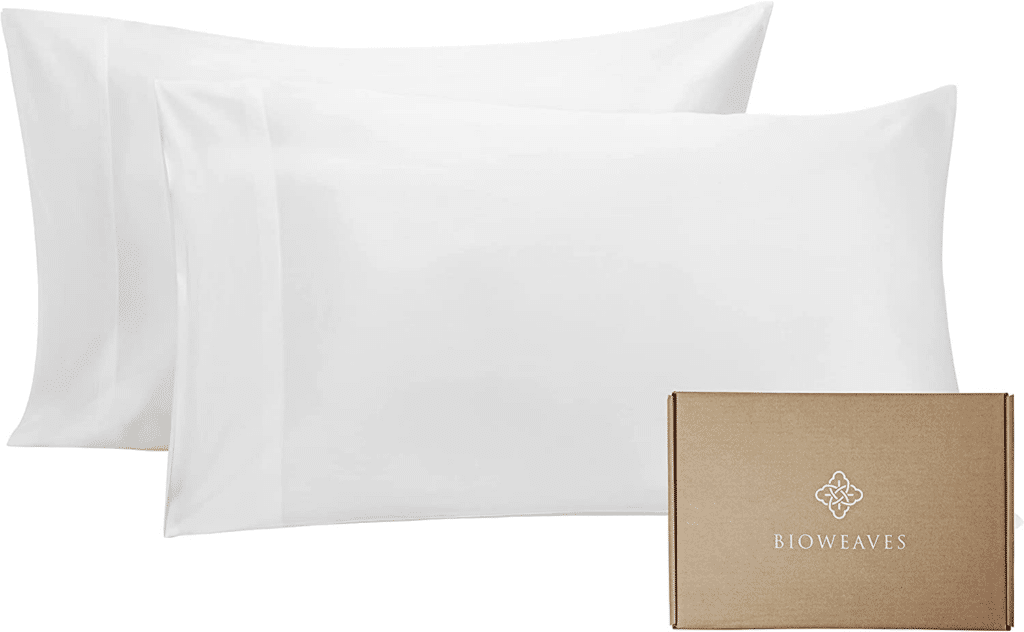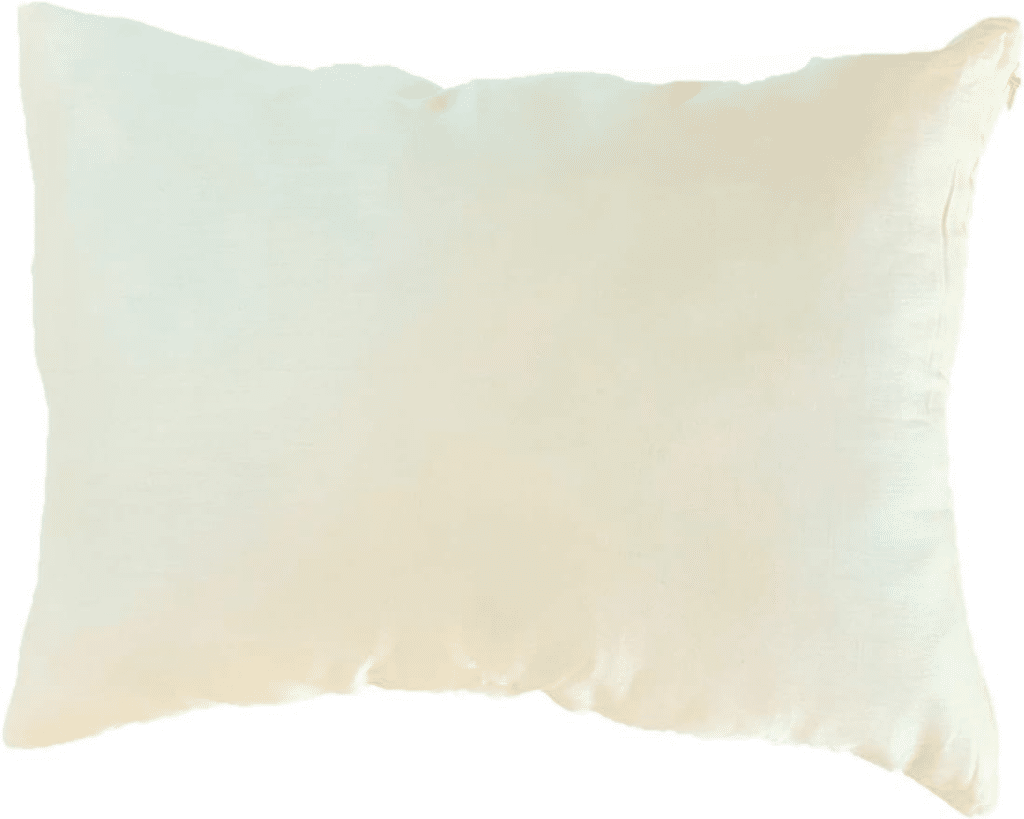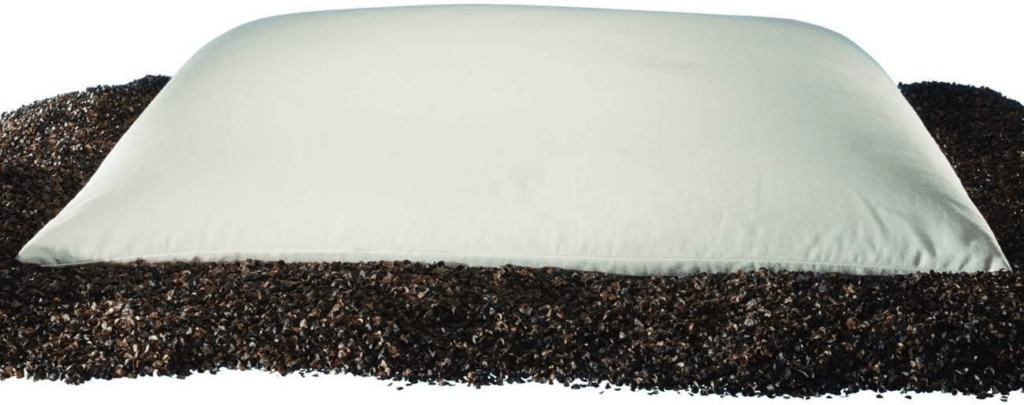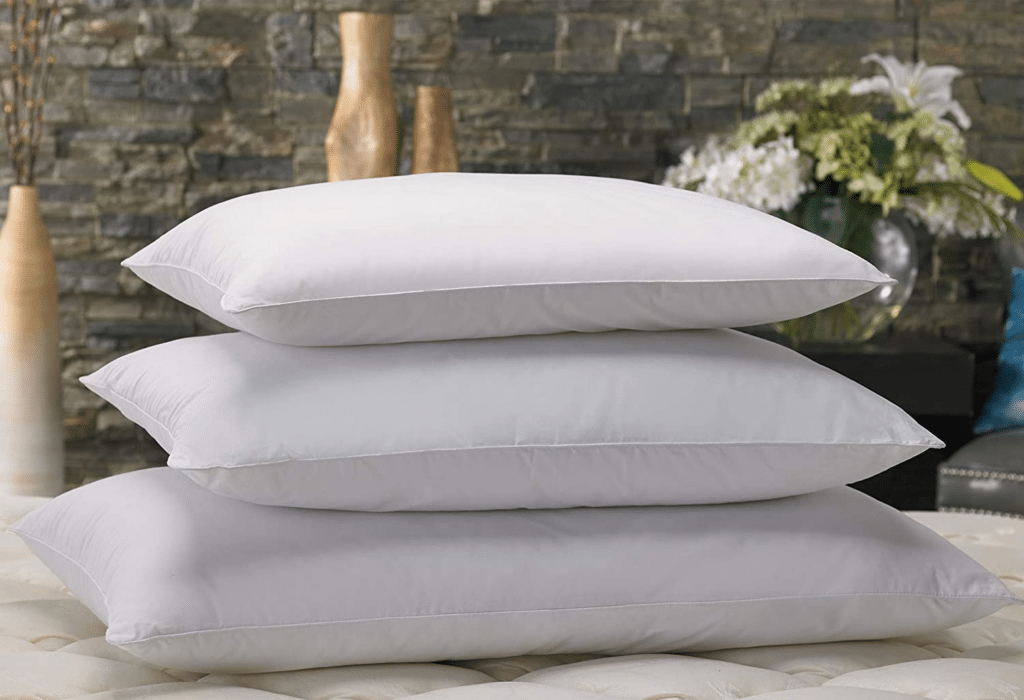Introduction – Sustainable Pillows And Non-Toxic Pillows
Our choices leave a mark on our planet’s canvas. Swapping out your ordinary pillow for an eco-friendly alternative isn’t just a switch in cushioning—it’s a daring pledge to a more sustainable existence. In this article we’ll venture together into the domain of sustainable, non-toxic and eco-friendly pillows.

We’ll also pull back the veil on the often overlooked carbon footprints left behind by traditional pillow manufacturing, and discovering the carbon-free world hidden within the stitches of each eco-friendly pillow option. So, strap yourselves in.
What Makes a Pillow Sustainable, Eco-Friendly, and Low-Carbon?
Materials Used In Sustainable Pillows
Sustainable and eco-friendly pillows stand out due to their use of organic or natural fibers, including materials like organic cotton, wool, and buckwheat hulls. In some cases, they even repurpose recycled materials, such as polyester derived from recycled plastic bottles. The use of these eco-friendly materials is twofold in benefit.
First, it allows for the conservation of resources, as the raw materials are either organically grown or reused. Second, it aids in minimizing waste, since materials that would have otherwise been discarded are instead given new life. In a broader sense, these pillows play a small but vital role in the global goal of carbon reduction, by reducing demand for synthetic, carbon-intensive materials and promoting a circular economy.
Reduced Use Of Energy In Manufacturing Processes
Energy use is directly related to carbon emissions, especially when the energy is sourced from fossil fuels such as coal, oil, or natural gas. Burning these fuels releases carbon dioxide, a greenhouse gas, into the atmosphere. Thus, the more energy a process uses, the more carbon is potentially emitted.
Environmentally friendly pillow manufacturers aim to reduce their energy use, and consequently their carbon footprint, through energy conservation measures and efficiency improvements in production processes.
Additionally, waste reduction is another significant aspect. Manufacturing waste can lead to increased energy use for disposal or recycling, so reducing waste can also help decrease energy use and carbon emissions.
Lastly, by adopting renewable energy sources, such as wind or solar power, these manufacturers can further reduce their carbon footprint. These energy sources are called “renewable” because they’re virtually inexhaustible and don’t emit carbon dioxide when used.
Certifications And Standards
To ensure a pillow is sustainable and eco-friendly, look for third-party certifications and standards like Global Organic Textile Standard (GOTS), OEKO-TEX Standard 100, or GREENGUARD Gold. These certifications guarantee that specific environmental criteria are met during production. Briefly, these are the following:
Global Organic Textile Standard (GOTS): This is one of the world’s leading and most recognized standards for organic textiles. Products carrying the GOTS label must contain at least 70% organic fibers, and all chemical inputs such as dyestuffs and auxiliaries used must meet certain environmental and toxicological criteria. The certification also promotes labor rights being respected.
OEKO-TEX Standard 100: A product with this certification ensures it has been tested for harmful substances. Products ranging from raw materials, to intermediates, and to end products at all stages of production, are eligible for this certification.
GREENGUARD Gold: Products with the GREENGUARD Gold certification have been tested for low chemical emissions, improving the quality of the air in which the products are used. The certification considers safety factors for children and elderly and environments like schools and healthcare facilities.
Understanding Carbon Impact Of Bedding

Carbon Emissions
Traditional pillow manufacturing can produce significant carbon emissions throughout the material sourcing, production, and transportation stages. By choosing sustainable options, consumers can reduce their carbon footprint and help protect the environment.
Environmental Benefits
Environmentally friendly pillows can help mitigate the impact of resource depletion and reduce waste. Additionally, some manufacturers partake in carbon-offsetting initiatives, further promoting the sustainable nature of their products.
Best Sustainable Pillows And Non-Toxic Pillows
Organic Cotton Pillows
Organic cotton pillows are made from pesticide-free cotton, which promotes soil health and protects water sources. These pillows provide a comfortable and breathable sleeping experience.
Recommendation: BIOWEAVES 100% Organic Cotton Pillow Cases

The BIOWEAVES pillow cases are a strong choice for those primarily interested in organic, sustainable products. They are crafted from 100% organic cotton that is certified by the Global Organic Textile Standard (GOTS), one of the highest authorities in organic textile certification. This guarantees the cotton was grown without the use of harmful pesticides or chemicals, and the same standards were maintained throughout its processing.
This commitment to organic practices extends beyond just the cotton. The product is produced in Fair Trade Certified facilities, which means ethical labor practices were upheld throughout the production process. The manufacturing processes are also sustainable, and the packaging is recyclable, meaning the product’s environmental impact is reduced at every stage.
The fabric, made from long staple cotton fibers, is crafted into a soft, 300 thread count sateen weave. This results in pillow cases that are not only organic and durable, but also soft and comfortable.
Organic Wool Pillows
Organic wool pillows are sourced from sheep raised without harmful chemicals, ensuring environmental sustainability alongside allergy-resistance and temperature regulation.
Recommendation: ORGANIC TEXTILES Natural Wool Filled Pillow

The GOTS certified ORGANIC TEXTILES wool-filled pillow stands out as a high-quality, environmentally-conscious product that prioritizes the use of organic materials. Filled with certified natural wool and protected by a removable cotton cover, this pillow aligns well with those seeking organic products that promise comfort and durability.
The cotton cover is also organic, adding another layer of natural, non-toxic material to the product.
The pillow’s construction is also noteworthy. It’s designed to last, with a plush light wool filling that not only provides comfort but also boasts moisture-wicking properties.
The availability of different sizes – from travel to king – shows that the company caters to a range of customer needs and environments.
Finally, their commitment to ethical manufacturing practices and fair labor standards, along with a concern for the environment and community, reflect a broader social responsibility.
Buckwheat Hull Pillows
Buckwheat hull pillows are made from the hard, outer layer of buckwheat seeds, offering firm support as well as being naturally hypoallergenic and biodegradable. Buckwheat hulls are known for their breathability and ability to promote cool sleep by allowing air to flow freely between the husks. This feature could be particularly appealing to those who tend to sleep hot or live in warmer climates.
The buckwheat hulls provide adjustable support, promising to cradle and align the head and neck correctly for maximum comfort. This adaptability suggests that it could be suitable for different types of sleepers, be they back, side, or stomach sleepers.
Recommendation: Sobakawa Traditional Buckwheat Standard Size Pillow

The Sobakawa Traditional Buckwheat Standard Size Pillow puts forth a focus on natural materials, using 100% muslin cotton fabric for its casing and 100% buckwheat hulls for its filling.
While the pillow claims to use “natural 100% muslin cotton,” it’s important to note that this doesn’t necessarily equate to organic cotton. There is no mention of the cotton being certified by any recognized organic standards such as GOTS.
That said, the use of 100% buckwheat hulls as filling material sets this pillow apart. Furthermore, the Sobakawa buckwheat pillow claims to be durable, indicating it could be a lasting investment.
Natural Latex Pillows
Derived from the sap of rubber trees, natural latex pillows provide contouring support and are biodegradable, hypoallergenic, and highly durable. Latex pillows like this one are often considered eco-friendly and sustainable due to their natural origins. However, potential buyers should be aware that ‘natural’ does not necessarily mean ‘organic.’
One standout feature of the latex pillow is its resilience. These pillows do not flatten over time, unlike some other types, maintaining their comfort and ‘springiness’. This suggests a longer lifespan and fewer replacements, adding to the sustainability factor.
As with many natural latex products, these pillows emit a slight aroma initially. This is typical of natural latex and should dissipate over time. Users who find this off-putting are advised to ventilate the pillow for 3-5 days.
Recommendation: Talalay Natural Latex Sleeping Pillow

The Tailalei Talalay Natural Latex Sleeping Pillow offers a range of features that may appeal to sleepers in search of a sustainable, medium-firmness pillow. As the name suggests, the primary fill material is Talalay natural latex, a material sourced from the sap of the rubber tree and processed in a manner that produces a very consistent, durable, and hypoallergenic pillow.
This pillow does not appear to carry any organic or eco-certifications.
The pillow comes double encased with an inner pillowcase and a zippered outer one, providing extra protection and potentially extending the life of the product. The outer pillowcase is described as thick and soft, which may enhance the overall comfort of the pillow. The case is also not described as organic.
The company also provides instructions for unpacking and restoring the pillow to its original size, as it is vacuum-packed for delivery. This kind of thoughtful guidance can be helpful to users and shows attention to the user experience.
Recycled Fiber Pillows
Recycled fiber pillows utilize materials like recycled polyester, which helps decrease waste and reduces the need for virgin resources.
Recommendation: Marriott Down Alternative Eco Pillow

One of the distinguishing aspects of this pillow is its fill being a unique polyester fiber spun from 100% recycled PET bottles, making them a genuinely sustainable choice. By repurposing PET bottles, which might otherwise contribute to landfill waste, these pillows help reduce environmental impact.
For comfort, these pillows feature a ‘cluster fiber’ fill, designed to offer plush support and maintain its shape over time. Being made of down alternative, these pillows are hypoallergenic, making them a suitable choice for sleepers with allergies.
However, it’s important to note that while the pillow fill is made from recycled materials, the product does not appear to hold any specific eco-certifications. Consumers prioritizing certified eco-friendly products may wish to consider this. The correct certification is Global Recycled Standard (GRS) since the product claims to use fibers spun from 100% recycled PET bottles.
Supporting Carbon Reduction Beyond Sustainable Pillows
Eco-Friendly Practices
In addition to choosing sustainable pillows, consider adopting eco-friendly practices in all aspects of bedding and bedroom care. This may include using organic bed linens and eco-conscious cleaning products, as well as employing energy-efficient temperature control.
Carbon-Neutral Sleep Accessories
To further improve your eco-friendly efforts, explore additional carbon-neutral sleep accessories, such as sustainably produced bed frames, organic mattress toppers, and climate-friendly blankets.
Safe and Sustainable Pillow Care
Cleaning and Maintenance
Properly clean and maintain your eco-friendly pillow according to the manufacturer’s recommendations to prolong its life and ensure it remains safe and hygienic.
Disposal and Recycling
When it’s time to replace your sustainable pillow, look for disposal and recycling options to minimize waste and continue supporting environmentally friendly practices.
Conclusion – Sustainable Pillows And Non-Toxic Pillows
Embracing sustainable and eco-friendly pillows is an important aspect of carbon reduction and healthier sleep. Make the change towards a greener lifestyle by adopting environmentally conscious pillow choices and promoting sustainable living in all aspects of your life.
